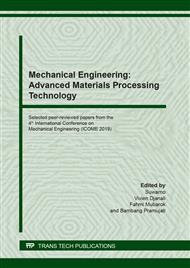p.17
p.25
p.32
p.41
p.48
p.54
p.62
p.68
p.75
The Effect of Acidity and Rotation Speed in Titanium Dioxide Synthesize Process
Abstract:
The aims of this study are to analyze the effect of acidity and rotational speed in the synthesis of TiO2 using the sol-gel method and to analyze the morphology of synthesized TiO2 nanoparticles and commercial TiO2 using XRD to produce semiconductors for Dye-Sensitized Solar Cell (DSSC) applications. The sol-gel method was used to synthesize TiO2 Nanoparticles. Titanium tetra-isopropoxide (TTIP) was used as a precursor with the variable of the magnetic stirrer rotation speed of 500, 1000 and 1500 rpm. Acidification was achieved by adding acetic acid to Sol-gel solution to produce a pH number of 1, 2, and 3. Nanomaterial was observed with an optical microscope and X-ray Powder Diffraction (X-RD) to determine the morphology and phase of TiO2 crystalline. The results showed that the rotational speed and acidity level of the Sol-gel solution ware played an important role to get the best form of a nanoparticle. At a rotation speed of 1500 rpm with pH 3 and 1000 rpm with pH 2 ware shown characteristics similar to commercial TiO2. In addition to that, the results of XRD characterization of synthesized TiO2 was shown a crystal phase of anatase structure with 18,046 nm crystal size compared to commercial TiO2 with anatase structure and crystal size of 15,554 nm.
Info:
Periodical:
Pages:
48-53
Citation:
Online since:
October 2020
Keywords:
Price:
Сopyright:
© 2020 Trans Tech Publications Ltd. All Rights Reserved
Share:
Citation:


